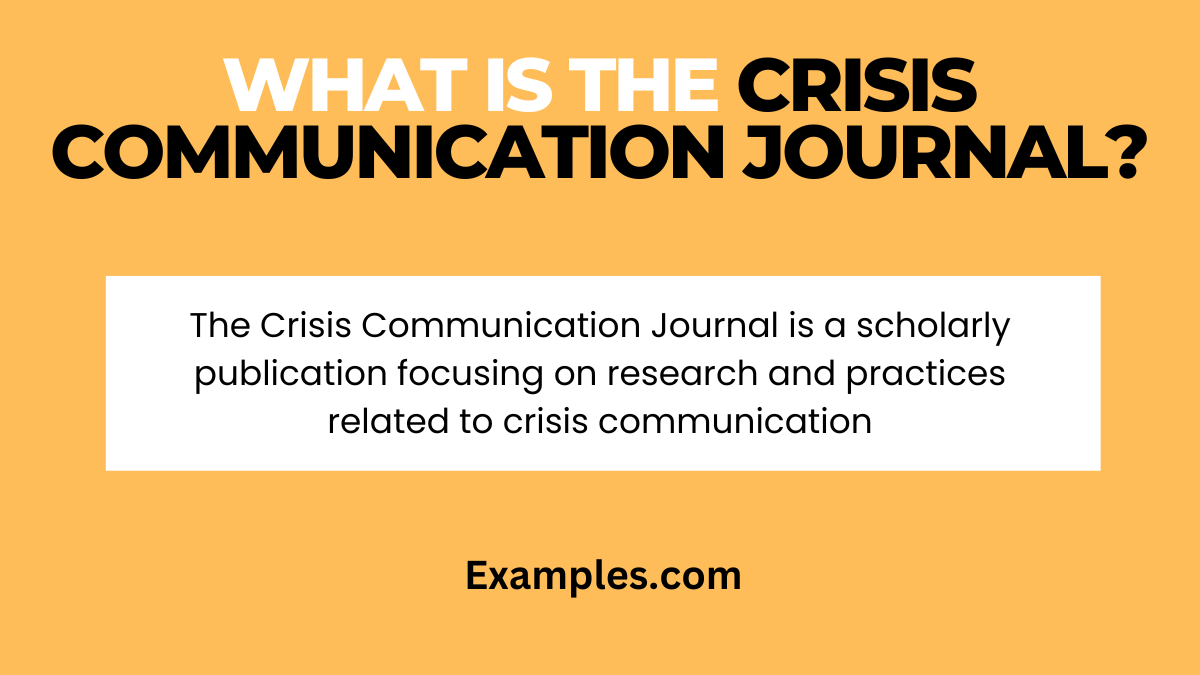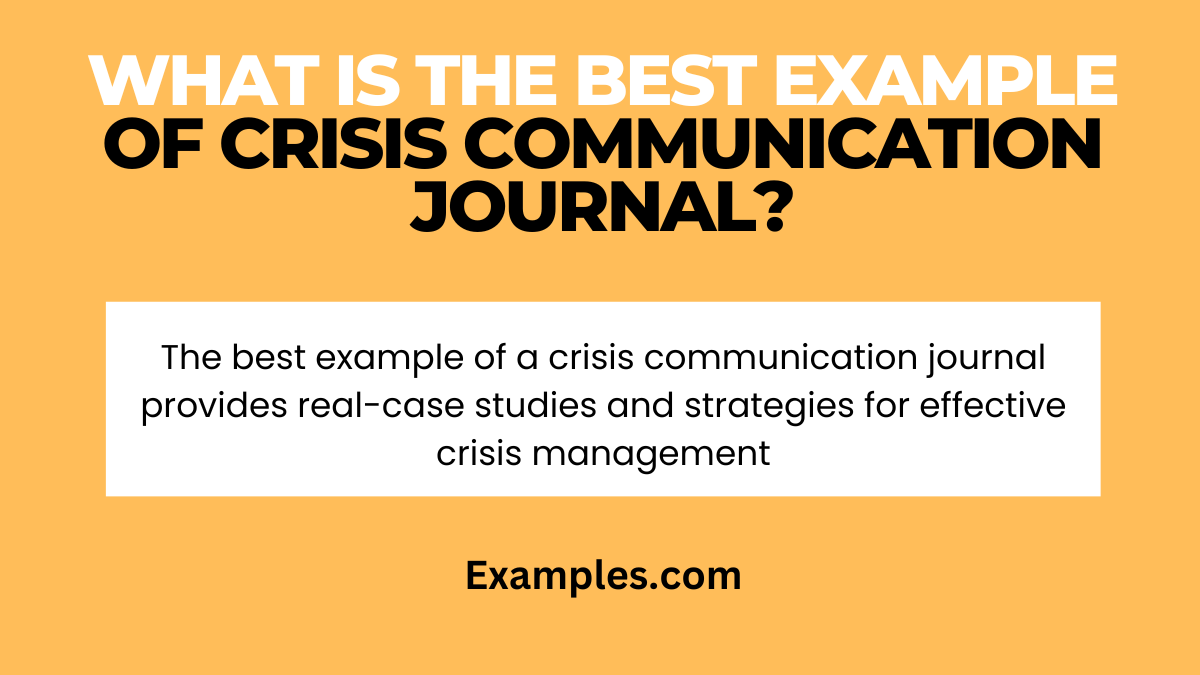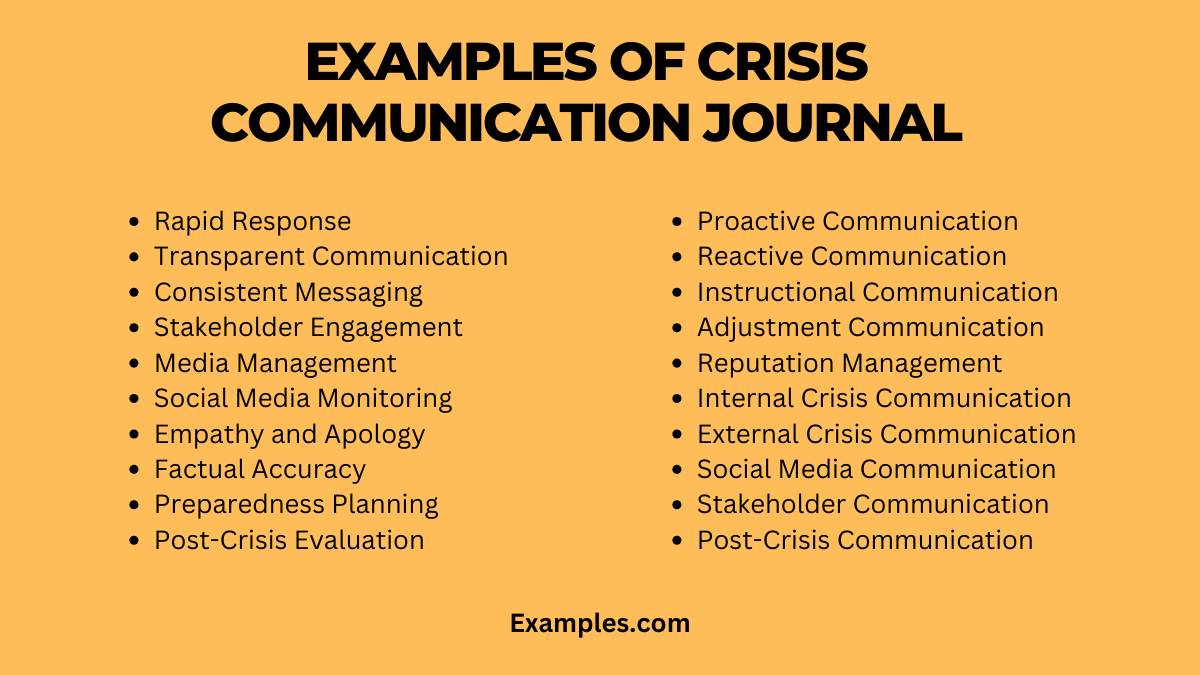19+ Crisis Communication Journal Examples
In an era where information spreads rapidly, the Crisis Communication Journal serves as a vital resource for professionals and organizations. This comprehensive guide dives deep into the strategies, examples, and essential principles of effective crisis communication. Understanding the nuances of conveying the right message during critical times is imperative. The Crisis Communication Journal equips readers with knowledge and tools to navigate these challenges confidently, ensuring messages are clear, compassionate, and constructive.
What is the Crisis Communication Journal?

The Crisis Communication Journal is an essential tool for understanding and implementing effective communication strategies during emergencies or crises. It encompasses a wide range of topics, from proactive planning to reactive response, offering in-depth insights into managing an organization’s communication effectively when it matters most.
What is the Best Example of Crisis Communication Journal?

The best example of a Crisis Communication Journal is one that includes comprehensive case studies, in-depth analysis of crisis response strategies, and expert opinions. This type of journal provides practical insights and actionable advice, helping readers develop a robust crisis communication plan.
20 Examples of Crisis Communication Journal

Explore the dynamic field of crisis communication with our journal, a rich resource featuring insights on crisis communication strategies, examples, and best practices. Dive into topics like rapid response, media management, stakeholder engagement, and reputation management. This journal is essential for professionals in public relations, business, healthcare, and education, offering theoretical frameworks and practical approaches to effective crisis management.
- Rapid Response: Swift reactions to crises are crucial; this example provides strategies for immediate action.
- Transparent Communication: Openness and honesty in communication build trust during crises.
- Consistent Messaging: Maintain a unified message across all channels for clarity.
- Stakeholder Engagement: Engage stakeholders effectively to manage perceptions.
- Media Management: Handle media interactions professionally to control the narrative.
- Social Media Monitoring: Real-time monitoring helps manage crisis discussions on social platforms.
- Empathy and Apology: Display empathy and issue sincere apologies when necessary.
- Factual Accuracy: Ensure accuracy to avoid misinformation.
- Preparedness Planning: Develop crisis plans in advance for a proactive response.
- Post-Crisis Evaluation: Analyze the crisis aftermath for continuous improvement.
- Proactive Communication: Anticipate crises and communicate preventive measures.
- Reactive Communication: Respond to crises as they occur with well-planned messages.
- Instructional Communication: Provide guidance and instructions during crises.
- Adjustment Communication: Adapt communication as the crisis evolves.
- Reputation Management: Protect and rebuild your reputation during crises.
- Internal Crisis Communication: Ensure internal teams are informed and aligned.
- External Crisis Communication: Manage external stakeholders effectively.
- Social Media Communication: Harness social media for crisis messaging.

- Stakeholder-Specific Communication: Tailor messages for different stakeholders.
- Post-Crisis Communication: Address the aftermath to restore normalcy.
Impact Factor for Crisis Communication Journal
- Definition of Impact Factor: The impact factor measures the frequency with which the average article in a journal has been cited in a particular year.
- Calculation Method: It’s calculated by dividing the number of citations in the current year by the total number of articles published in the two previous years.
- Significance for Academics: A higher impact factor is often seen as a symbol of prestige and quality in academic journals.
- Influence on Research Funding: Journals with higher impact factors are more likely to attract accomplished researchers and funding.
- Critiques of the Impact Factor: Critics argue it may not accurately reflect the quality of individual articles.
- Alternative Metrics: Other metrics like h-index and article-level metrics are gaining popularity.
- Impact on Crisis Communication Field: In the context of crisis communication, a higher impact factor can attract more specialized and high-quality research.
- Evolving Nature: Impact factors can change annually, reflecting the journal’s evolving influence in its field.
Crisis Communication Journal Topics
- Theory and Models: Exploring theoretical models in crisis communication.
- Case Studies: Analysis of real-world crisis communication scenarios.
- Digital Media: The role of social media and digital platforms in crisis communication.
- Stakeholder Analysis: Understanding the perspectives of different stakeholders in a crisis.
- Ethics and Responsibility: Ethical considerations in communicating during crises.
- Global Communication: Cross-cultural aspects of crisis communication.
- Strategy Development: Creating effective crisis communication strategies.
- Post-Crisis Analysis: Evaluating communication effectiveness after a crisis.
What We Don’t Know about Crisis Communication Journal
- Long-term Impact: Understanding the long-term effects of crisis communication strategies.
- Non-verbal Communication: The role of non-verbal cues in crisis situations.
- Psychological Aspects: The psychological impact of crisis communication on audiences.
- Emerging Technologies: How emerging technologies are reshaping crisis communication.
- Crisis Prevention: Focusing on communication strategies that prevent crises.
- Interdisciplinary Approaches: Integration with other fields like psychology or sociology.
- Cultural Sensitivity: How different cultures interpret crisis communication.
- Legal Implications: Legal considerations and constraints in crisis communication.
Importance of Crisis Communication Journal
- Educational Resource: Provides a comprehensive learning tool for students and professionals.
- Knowledge Sharing: Facilitates the sharing of latest research and best practices.
- Policy Influence: Influences policy-making in crisis management.
- Professional Development: Helps professionals stay updated with evolving strategies.
- Global Perspective: Offers insights into crisis communication on an international scale.
- Networking Platform: Connects researchers, practitioners, and policymakers.
- Quality Control: Ensures high standards of research and information dissemination.
- Future Trends: Highlights emerging trends and future directions in crisis communication.
Crafting a Crisis Communication Journal requires careful analysis of real-world crises, offering valuable insights. Utilizing the provided guide and tips, one can compile a comprehensive resource that educates and guides others in crisis management. By documenting successful strategies and lessons learned, this journal becomes an essential tool for professionals navigating challenging communication scenarios, ultimately promoting resilience and preparedness.



